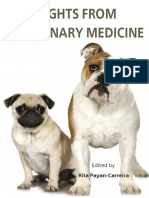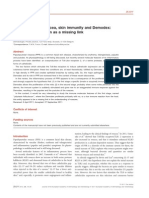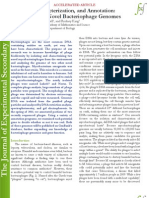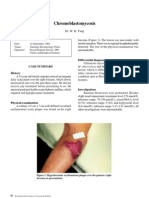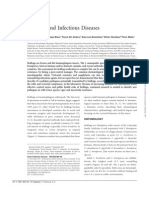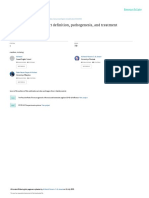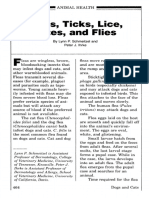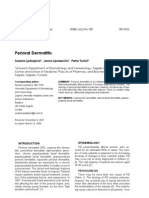Demodex Mites - Commensals, Parasites or Mutualistic Organisms?
Demodex Mites - Commensals, Parasites or Mutualistic Organisms?
Uploaded by
SMA Negeri 1 SedayuCopyright:
Available Formats
Demodex Mites - Commensals, Parasites or Mutualistic Organisms?
Demodex Mites - Commensals, Parasites or Mutualistic Organisms?
Uploaded by
SMA Negeri 1 SedayuOriginal Title
Copyright
Available Formats
Share this document
Did you find this document useful?
Is this content inappropriate?
Copyright:
Available Formats
Demodex Mites - Commensals, Parasites or Mutualistic Organisms?
Demodex Mites - Commensals, Parasites or Mutualistic Organisms?
Uploaded by
SMA Negeri 1 SedayuCopyright:
Available Formats
Editorial
Dermatology 2011;222:128–130 Published online: January 11, 2011
DOI: 10.1159/000323009
Demodex Mites – Commensals, Parasites
or Mutualistic Organisms?
Noreen Lacey Síona Ní Raghallaigh Frank C. Powell
UCD Clinical Research Centre and Regional Centre of Dermatology, Mater Misericordiae University Hospital,
Dublin, Ireland
The German dermatologist Gustav Simon is credited ated, he proposed that the life cycle of D. folliculorum
with the first description of Demodex mites [1]. He was mites was about 14.5 days. He also demonstrated that all
studying the microanatomical structure of acne vulgaris life stages of these mites were negatively phototaxic, that
lesions by examining material expressed from sebaceous is they were more mobile in a dark environment and rel-
follicles under the microscope. He noted structures with- atively inert when bright light was shone on them. How-
in this material and was able to identify a worm-like ob- ever, until optimal in vitro culture techniques and condi-
ject with a head, legs, and anterior and posterior body tions allow Demodex proliferation in the laboratory, the
parts that made him think this was ‘an animal’ of some true life cycle of Demodex remains uncertain. Mites are
sort. Suspicion became certainty when he pressed the ob- mobile and can travel at a speed of up to 16 mm/h [6].
ject gently between two slides and observed that ‘it Mites found from time to time on the skin surface suggest
moved’! The term Demodex was coined by Richard Owen that they emerge from follicles (probably at night to avoid
in 1843 for this genus [2], borrowing from the Greek the light exposure) and migrate across the surface of the fa-
words ‘demo’ (lard) and ‘dex’ (boring worm) to describe cial skin.
the form and location of preference of this organism. The Mites are known to contain lipase enzymes [7], to car-
anatomical details were subsequently described by Desch ry bacteria on the surface [6] and they may have endobac-
and Nutting [3, 4]. These included (for Demodex follicu- teria [8].
lorum) 4 pairs of articulated legs, complex mouth parts, Any potential role of these complex organisms in the
genital organs (either penis or vagina), a rudimentary biobalance of the skin has been largely ignored. They are
gastrointestinal tract but surprisingly no anus! regarded by most investigators as simple commensals
We now know that 2 mite species (Demodex brevis and benefiting from the human sebum in its sheltered eco-
D. folliculorum) inhabit normal adult human facial seba- logical follicular niche and without adversely affecting its
ceous follicles. Mites are not found in the skin of newborn host, but in animals the pathogenic potential of Demodex
infants. Sebaceous follicles are thought to become colo- species is well documented. Demodectic mange in dogs
nised during later childhood and early adult life by trans- is a potentially lethal condition, and goats can be simi-
fer from adult family members. The mites’ life cycle was larly affected. Both disorders are caused by a massive pro-
studied by Spickett [5] by histological and rudimentary liferation of the normal mite population [9]. In humans
in vitro experiments. From a synthesis of this data gener- there is mounting evidence that Demodex mites, like oth-
© 2011 S. Karger AG, Basel Frank C. Powell
1018–8665/11/2222–0128$38.00/0 Mater Misericordiae University Hospital
Fax +41 61 306 12 34 Eccles Street
E-Mail karger@karger.ch Accessible online at: Dublin 7 (Ireland)
www.karger.com www.karger.com/drm Tel. +353 1 803 2000, Fax +353 1 803 4779, E-Mail fpowell @ eircom.net
er cutaneous microflora, may be opportunistic patho- the canal under control without inducing an inflamma-
gens, that is they have the potential to change status from tory response. If mite numbers increase to a critical level
commensals to parasites (the mites benefit but cause (possibly causing physical distension of follicles with kera-
harm to the host) if the host cutaneous environment fa- tinocyte disruption), they possibly develop a pathogenic
cilitates their proliferation [10, 11]. role causing host ‘insult’. Thus, cytokine/chemokine re-
Demodex mite numbers have been repeatedly shown lease may be initiated, and a humoral immune inflamma-
to be increased in patients with rosacea, and a recent re- tory response ensues with clinically visible cutaneous
port using meta-analysis of previous studies has shown a changes. If the follicle is damaged to the point of rupture,
statistically significant association between Demodex a granulomatous ‘foreign-body’ type of reaction subse-
species infestation and the development of rosacea [12]. quently results.
Rosaceiform dermatitis has been reported following re- Several factors could allow proliferation of mites to
peated facial application of topical steroids and other im- this critical level. For example the particular physical
munomodulators with similarly increased numbers of barrier characteristics of an individual’s facial skin may
mites recorded [13]. Several other studies have shown that facilitate their increased population. Our preliminary
Demodex mite numbers are increased in immunosup- studies have shown that patients with papulopustular ro-
pressed patients, children with leukaemia receiving che- sacea have increased facial pH and reduced skin surface
motherapy [14], patients with HIV infection and AIDS hydration levels [20]. Papulopustular rosacea patients
[15, 16], patients undergoing phototherapy [17] and pa- also have abnormal fatty acid composition of their skin
tients on chronic dialysis [18]. surface lipid layer, with increased levels of linoleic acid
In this issue, Gerber et al. [19] introduce a new clinical and myristic acid, as well as reduced levels of specific sat-
setting in which Demodex numbers were found to be in- urated fatty acids [21]. This type of facial cutaneous mi-
creased. In their retrospective study these authors demon- croenvironment may prove conducive to mite prolifera-
strated increased numbers of D. folliculorum in the cheek tion. Alternatively, the aberrant innate immune response
region of patients presenting with papulopustular lesions as previously reported in rosacea patients [22] may facili-
induced by epidermal growth factor receptor inhibitor tate mite multiplication to the point where the humoral
following therapy for cancer. The authors propose that response is initiated and cutaneous inflammation results.
their findings suggest that epidermal growth factor recep- The role of suppression of the host immune response
tor inhibitor may reduce/impair cutaneous defence mech- in the facilitation of mite proliferation is suggested by the
anisms resulting in increased Demodex proliferation. studies cited above and the publication by Gerber et al.
Our present state of knowledge suggests that Demodex [19] in this issue.
mites normally have a symbiotic relationship with hu- Studies of Demodex mites and their role in healthy
mans. In usual circumstances they appear to live as com- skin as well as their potential to cause host damage have
mensals feeding on their host’s sebum. It is possible in this the potential to give insight into this complex and impor-
role that they may even confer a mutualistic host benefit tant area of cutaneous medicine. It may well be that De-
by ingesting bacteria or other organisms in the follicular modex mites, like some cutaneous microbes, take on dif-
canal. The host’s innate immune system appears to toler- ferent roles depending on host status [23], changing from
ate the presence of these mites (possibly being downregu- commensals (or even mutuals) to parasites as the host’s
lated by the mites themselves) but it may have a ‘culling’ or defences are altered.
inhibitory effect on mite proliferation keeping numbers in
References
1 Crissey JT, Parish LC: The Dermatology and 4 Desch CE, Nutting WB: Morphology and 7 Acosta FJ, Planas L, Penneys N: Demodex
Syphilology of the Nineteenth Century. functional anatomy of Demodex folliculo- mites contain immunoreactive lipase. Arch
Westport, Praeger Publishers, 1981, p 124. rum (Simon) of man. Acarologia 1977; 19: Dermatol 1989;125:1432–1433.
2 Owen R: Lectures on the Comparative Anat- 422–462. 8 Lacey N, et al: Mite-related bacterial anti-
omy and Physiology of the Invertebrate Ani- 5 Spickett SG: Studies on Demodex folliculo- gens stimulate inflammatory cells in rosa-
mals. London, Longman, 1843, pp 251–252. rum Simon. Parasitology 1961; 51:181–192. cea. Br J Dermatol 2007;157:474–481.
3 Desch C, Nutting WB: Demodex folliculo- 6 Norn MS: The follicle mite (Demodex follicu- 9 Scott DW, Miller WH, Griffin CE: Muller
rum (Simon) and D. brevis Akbulatova of lorum). Eye Ear Nose Throat Mon 1972; 51: and Kirk’s Small Animal Dermatology, ed 6.
man: redescription and reevaluation. J Para- 187–191. Philadelphia, Saunders, 2001, pp 457–513.
sitol 1972;58:169–177.
Demodex – Commensal, Parasitic or Dermatology 2011;222:128–130 129
Mutualistic?
10 Dahl MV, Ross AJ, Schlievert PM: Tempera- 15 Aquilina C, Viraben R, Sire S: Ivermectin- 19 Gerber PA, Kukova G, Buhren BA, Homey
ture regulates bacterial protein production: responsive Demodex infestation during hu- B: Density of Demodex folliculorum in
possible role in rosacea. J Am Acad Dermatol man immunodeficiency virus infection. patients receiving epidermal growth factor
2004;50:266–272. Dermatology 2002;205:394–397. receptor inhibitors. Dermatology DOI:
11 Whitfeld M, et al: Staphylococcus epidermi- 16 Dominey A, Rosen T, Tschen J: Papulonodu- 10.1159/000323001.
dis: a possible role in the pustules of rosacea. lar demodicidosis associated with acquired 20 Ní Raghallaigh S, Powell FC: The cutaneous
J Am Acad Dermatol, E-pub ahead of print. immunodeficiency syndrome. J Am Acad microenvironment in papulopustular rosa-
12 Zhao YE, Wu LP, Peng Y, Cheng H: Retro- Dermatol 1989;20:197–201. cea. Br J Dermatol 2009;161:25.
spective Analysis of the association between 17 Kulac M, Ciftci IH, Karaca S, Cetinkaya Z: 21 Ní Raghallaigh S, Bender K, Lacey N, Bren-
Demodex infestation and rosacea. Arch Der- Clinical importance of Demodex folliculo- nan L, Powell FC: The fatty acid profile of the
matol 2010;146:896–902. rum in patients receiving phototherapy. Int J skin surface lipid layer in patients with papu-
13 Fujiwara S, Okubo Y, Irisawa R, Tsuboi R: Dermatol 2008;47:72–77. lopustular rosacea. J Invest Dermatol 2010;
Rosaceiform dermatitis associated with top- 18 Karincaoglu Y, Seyhan ME, Bayran N, Aycan 130:S65.
ical tacrolimus treatment. J Am Acad Der- O, Taskapan H: Incidence of Demodex fol- 22 Yamasaki K, et al: Increased serine protease
matol 2010;62:1050–1052. liculorum in patients with end stage chronic activity and cathelicidin promotes skin in-
14 Ivy SP, Mackall CL, Gore L, et al: Demodici- renal failure. Renal Failure 2005;27:495–499. flammation in rosacea. Nat Med 2007; 13:
dosis in childhood acute lymphoblastic leu- 975–980.
kemia: an opportunistic infection occurring 23 Cogen AL, Nizet V, Gallo RL: Skin microbi-
with immunosuppression. J Paediatr 1995; ota: a source of disease or defence? Br J Der-
127:751–754. matol 2008;158:442–455.
130 Dermatology 2011;222:128–130 Lacey/Ní Raghallaigh/Powell
You might also like
- Insights From Veterinary MedicineDocument290 pagesInsights From Veterinary Medicinenorma paulina carcausto lipaNo ratings yet
- Veterinary EctoparasitesDocument8 pagesVeterinary Ectoparasitesc3891446100% (1)
- Demodicosis in Different Age Groups and AlternativDocument23 pagesDemodicosis in Different Age Groups and AlternativJuliana FreitasNo ratings yet
- Reviews: Demodex - An Old Pathogen or A New One?Document4 pagesReviews: Demodex - An Old Pathogen or A New One?Catherine IbtisamahNo ratings yet
- Potential Role of Demodex Mites and Bacteria in The Induction of RosaceaDocument7 pagesPotential Role of Demodex Mites and Bacteria in The Induction of RosaceaSMA Negeri 1 SedayuNo ratings yet
- WilliamsDocument10 pagesWilliamsTrustia RizqandaruNo ratings yet
- Snail Mucus Filtrate Reduces InflammatioDocument9 pagesSnail Mucus Filtrate Reduces InflammatioSHYLESH BNo ratings yet
- Mycology - Chapter Six Dimorphic Fungi: BLASTOMYCOSIS (Blastomyces Dermatitidis)Document16 pagesMycology - Chapter Six Dimorphic Fungi: BLASTOMYCOSIS (Blastomyces Dermatitidis)ginarsih99_hutamiNo ratings yet
- Symptomatic Vulvar Demodicosis: A Case Report and Review of The LiteratureDocument4 pagesSymptomatic Vulvar Demodicosis: A Case Report and Review of The LiteratureSilvia Yin CM100% (1)
- Challenges in Exploring and Manipulating The Human Skin Microbiome 2021Document14 pagesChallenges in Exploring and Manipulating The Human Skin Microbiome 2021Vera Brok-Volchanskaya100% (1)
- Demo Mite PDF Dermatolgy StudyDocument10 pagesDemo Mite PDF Dermatolgy StudyhLooneygirlNo ratings yet
- The Microbiome in Patients With Atopic Dermatitis: Current PerspectivesDocument10 pagesThe Microbiome in Patients With Atopic Dermatitis: Current PerspectivesPande Agung MahariskiNo ratings yet
- The Microbiome in Patients With Atopic Dermatitis: Current PerspectivesDocument12 pagesThe Microbiome in Patients With Atopic Dermatitis: Current Perspectivessaifullahkhan57580No ratings yet
- Current Topics in Dermatophyte Classification and Clinical DiagnosisDocument23 pagesCurrent Topics in Dermatophyte Classification and Clinical DiagnosisGiuseppe FerraraNo ratings yet
- Facial Dermatosis Associated With DemodexDocument8 pagesFacial Dermatosis Associated With DemodexRoxana SurliuNo ratings yet
- Bakteri S EpidermisDocument15 pagesBakteri S EpidermisSheillaizza FadhillaNo ratings yet
- Leprosy An Overview of PathophysiologyDocument7 pagesLeprosy An Overview of PathophysiologyDurga MadhuriNo ratings yet
- Darmstadt 1994Document15 pagesDarmstadt 1994rismahNo ratings yet
- Leprosy: CharacteristicsDocument10 pagesLeprosy: Characteristicsanon-374466No ratings yet
- HFPCH01Document22 pagesHFPCH01collegeassignmenthelp813No ratings yet
- Journal Pone 0251136Document16 pagesJournal Pone 0251136Eldie RahimNo ratings yet
- Scabies and Pediculosis: Neglected Diseases To Highlight: Article Published Online: 1 February 2012Document2 pagesScabies and Pediculosis: Neglected Diseases To Highlight: Article Published Online: 1 February 2012Anonymous TVwR0FNo ratings yet
- Microbioma Da Pele Função e EstruturaDocument9 pagesMicrobioma Da Pele Função e EstruturaGjiiNo ratings yet
- Morphobiometrical and Molecular Study of Two Populations of Demodex Folliculorum From HumansDocument7 pagesMorphobiometrical and Molecular Study of Two Populations of Demodex Folliculorum From Humansduverney.gaviriaNo ratings yet
- Microbiom Skin VariabilityDocument5 pagesMicrobiom Skin VariabilityDianaNo ratings yet
- Microorganisms 09 00543 v2Document19 pagesMicroorganisms 09 00543 v2Pande Agung MahariskiNo ratings yet
- Isolation, Characterization, and Annotation: The Search For Novel Bacteriophage GenomesDocument9 pagesIsolation, Characterization, and Annotation: The Search For Novel Bacteriophage GenomeskeitabandoNo ratings yet
- Role of The Skin Microbiome in Atopic Dermatitis: Review Open AccessDocument6 pagesRole of The Skin Microbiome in Atopic Dermatitis: Review Open Accesssaifullahkhan57580No ratings yet
- Microbiota y DermatitisDocument6 pagesMicrobiota y Dermatitisdayenu barraNo ratings yet
- DemodexDocument5 pagesDemodexmigas1996No ratings yet
- Paederus Dermatitis An Outbreak On A Medical Mission AmazonDocument3 pagesPaederus Dermatitis An Outbreak On A Medical Mission AmazonrrrawNo ratings yet
- Hipersensibilidad 3Document3 pagesHipersensibilidad 3Xóchitl Daniela GuzmánNo ratings yet
- Demodex Follicullorum Mimicking Fungal Infection A Case ReportDocument2 pagesDemodex Follicullorum Mimicking Fungal Infection A Case ReportAnonymous V5l8nmcSxb100% (1)
- Flynn Et Al 2013 Interaction of Mycobacterium Leprae With Human Airway Epithelial Cells Adherence Entry Survival andDocument15 pagesFlynn Et Al 2013 Interaction of Mycobacterium Leprae With Human Airway Epithelial Cells Adherence Entry Survival anddamayantiwenny24No ratings yet
- المستند بحث المختبراتDocument3 pagesالمستند بحث المختبراترافت العواضيNo ratings yet
- Nihms891003. MicrobiomaDocument22 pagesNihms891003. MicrobiomaEugeniaNo ratings yet
- Adhesion Properties of Toxigenic Corynebacteria: ReviewDocument19 pagesAdhesion Properties of Toxigenic Corynebacteria: ReviewJesica Perez VergaraNo ratings yet
- Effectiveness of Five Antidandruff Cosmetic Formulations Against Planktonic Cells and Biofilms of DermatophytesDocument7 pagesEffectiveness of Five Antidandruff Cosmetic Formulations Against Planktonic Cells and Biofilms of Dermatophytesjeane wattimenaNo ratings yet
- Host Immune Responses To The Itch Mite, Sarcoptes Scabiei, in HumansDocument12 pagesHost Immune Responses To The Itch Mite, Sarcoptes Scabiei, in HumansSilvia RNo ratings yet
- Buffalo LeprosyDocument4 pagesBuffalo LeprosyALTAF HUSAINNo ratings yet
- Pathogenesisofdermatophytosis PIIS0738081 X09002570Document6 pagesPathogenesisofdermatophytosis PIIS0738081 X09002570arian1274344565No ratings yet
- 33 Prozesky 1982Document10 pages33 Prozesky 1982Keto PrehranaNo ratings yet
- Chromoblastomycosis: Differential DiagnosesDocument4 pagesChromoblastomycosis: Differential DiagnosesPranab ChatterjeeNo ratings yet
- A Five-Year Survey of Dematiaceous Fungi in A Tropical Hospital.Document11 pagesA Five-Year Survey of Dematiaceous Fungi in A Tropical Hospital.Anonymous argZ1ZNo ratings yet
- Post Covid Effects of Black Fungus Mucormycosis: A ReviewDocument7 pagesPost Covid Effects of Black Fungus Mucormycosis: A ReviewIJAR JOURNALNo ratings yet
- 2019 - Leprosy A Great ImitatorDocument13 pages2019 - Leprosy A Great ImitatorDEEVA SKINCARENo ratings yet
- Bedbugs and Infectious Diseases: ReviewarticleDocument11 pagesBedbugs and Infectious Diseases: ReviewarticleSurferilla WavesNo ratings yet
- Severe DermatoDocument13 pagesSevere DermatoadriantiariNo ratings yet
- What Can We Learn and What Do We Need To Know Amidst The Iatrogenic Outbreak of Exserohilum Rostratum Meningitis?Document8 pagesWhat Can We Learn and What Do We Need To Know Amidst The Iatrogenic Outbreak of Exserohilum Rostratum Meningitis?Galuh Kresna BayuNo ratings yet
- DermatophytosisDocument6 pagesDermatophytosisTedi MulyanaNo ratings yet
- Cold Spring Harb Perspect Med-2014-White-a019802Document17 pagesCold Spring Harb Perspect Med-2014-White-a019802fansofmileycyrus.12102001No ratings yet
- 10 1111@ijd 13748 PDFDocument11 pages10 1111@ijd 13748 PDFBerliana Kurniawati Nur HudaNo ratings yet
- Loa LoaDocument22 pagesLoa LoaphilmonNo ratings yet
- Quantification of Demodex Folliculorum by PCR in RosaceaDocument6 pagesQuantification of Demodex Folliculorum by PCR in RosaceaRoxana SurliuNo ratings yet
- Epidemiologi PedikulosisDocument6 pagesEpidemiologi Pedikulosisnadira wardaNo ratings yet
- chromoblastomycosisDocument7 pageschromoblastomycosisindahNo ratings yet
- Scabies Mites Alter The Skin Microbiome and PromoteDocument13 pagesScabies Mites Alter The Skin Microbiome and Promotemohammed bouchibaNo ratings yet
- Skin MicrobiotaDocument4 pagesSkin MicrobiotaDianaNo ratings yet
- Leprosy: An Overview of Pathophysiology: Disusun OlehDocument22 pagesLeprosy: An Overview of Pathophysiology: Disusun OlehDwi Endra Juli PraditoNo ratings yet
- Staphylococcal-Scalded Skin Syndrome: Evaluation, Diagnosis, and ManagementDocument6 pagesStaphylococcal-Scalded Skin Syndrome: Evaluation, Diagnosis, and ManagementM Daffa Abhista ReviansyahNo ratings yet
- Systemic MycosisDocument28 pagesSystemic MycosisadiNo ratings yet
- Erysipeloid Unveiled: Understanding, Diagnosis, and Progressive StrategiesFrom EverandErysipeloid Unveiled: Understanding, Diagnosis, and Progressive StrategiesNo ratings yet
- A Consideration in The Itchy or Overgrooming Cat: Feline DemodicosisDocument5 pagesA Consideration in The Itchy or Overgrooming Cat: Feline DemodicosisBirdella GwenNo ratings yet
- Facial Dermatosis Associated With DemodexDocument8 pagesFacial Dermatosis Associated With DemodexRoxana SurliuNo ratings yet
- 14.2 Community Interactions BookDocument7 pages14.2 Community Interactions BookjordanNo ratings yet
- Demodex Infestation Requires Immediate, Aggressive Treatment by Doctor, Patient - Primary Care Optometry NewsDocument5 pagesDemodex Infestation Requires Immediate, Aggressive Treatment by Doctor, Patient - Primary Care Optometry NewsΔιονύσης ΦιοραβάντεςNo ratings yet
- 14.2 Community InteractionsDocument7 pages14.2 Community InteractionsColin PraterNo ratings yet
- Anti-Demodectic Effects of Okra Eyelid Patch in Demodex Blepharitis Compared With Tea Tree OilDocument8 pagesAnti-Demodectic Effects of Okra Eyelid Patch in Demodex Blepharitis Compared With Tea Tree OilAndi SilpiaNo ratings yet
- Demodex Mites - Commensals, Parasites or Mutualistic Organisms?Document3 pagesDemodex Mites - Commensals, Parasites or Mutualistic Organisms?SMA Negeri 1 SedayuNo ratings yet
- DemodexDocument15 pagesDemodexhtandowNo ratings yet
- Article of Demodecosis in Dog-DikonversiDocument12 pagesArticle of Demodecosis in Dog-DikonversiSosial EkonomiNo ratings yet
- Microorganisms 09 00543 v2Document19 pagesMicroorganisms 09 00543 v2Pande Agung MahariskiNo ratings yet
- Demodex CanisDocument19 pagesDemodex Canisapi-337841627No ratings yet
- Acariasis: ImportanceDocument17 pagesAcariasis: ImportanceCristina Maria CampeanNo ratings yet
- Fleas, Ticks, Lice, Mites, and Flies: Animal HealthDocument8 pagesFleas, Ticks, Lice, Mites, and Flies: Animal HealthAwwal DayyabuNo ratings yet
- Pi Is 2352512623001133Document2 pagesPi Is 2352512623001133luizaca18082007No ratings yet
- Veterinary Parasitology The Practical Veterinarian 1st Edition Lora A. Ballweber Dvm Ms All Chapters Instant DownloadDocument81 pagesVeterinary Parasitology The Practical Veterinarian 1st Edition Lora A. Ballweber Dvm Ms All Chapters Instant Downloadpawaebethic69100% (2)
- Entrepreneurial Finance A Global Perspective Gary Gibbons & Robert D. Hisrich & Carlos M. DaSilva 2024 Scribd DownloadDocument34 pagesEntrepreneurial Finance A Global Perspective Gary Gibbons & Robert D. Hisrich & Carlos M. DaSilva 2024 Scribd Downloadlumieonissi100% (1)
- Hom M, Demodex - Clinical Cases & Diagnostic Protocol. OVS 2013Document8 pagesHom M, Demodex - Clinical Cases & Diagnostic Protocol. OVS 2013cassie_kuldaNo ratings yet
- Book-Chapter LiuDocument7 pagesBook-Chapter LiuHafidz ArkanNo ratings yet
- Perioral DermatitisDocument5 pagesPerioral DermatitisAstriana IndrawatiNo ratings yet
- Topical Application of 1-Methylnicotinamide in The TreatmentDocument4 pagesTopical Application of 1-Methylnicotinamide in The TreatmentHilda FitriaNo ratings yet
- Case Report in EnglishDocument9 pagesCase Report in EnglishsashadilanNo ratings yet
- Skin ScrapeDocument7 pagesSkin ScrapeShanmathiNo ratings yet
- Demodex Follicullorum Mimicking Fungal Infection A Case ReportDocument2 pagesDemodex Follicullorum Mimicking Fungal Infection A Case ReportAnonymous V5l8nmcSxb100% (1)
- Trichoscopic Diagnosis of Cutaneous Pelodera Strongyloides Infestation in A DogDocument5 pagesTrichoscopic Diagnosis of Cutaneous Pelodera Strongyloides Infestation in A DogRebeka MenezesNo ratings yet
- Demodicosis Caused by Demodex Canis and Demodex Cornei in DogsDocument4 pagesDemodicosis Caused by Demodex Canis and Demodex Cornei in DogsAdriansyah RamadhanNo ratings yet
- Jurnal 1.topical Ivermectin-Metronidazole Gel Therapy in The Treatment of BlepharitisDocument6 pagesJurnal 1.topical Ivermectin-Metronidazole Gel Therapy in The Treatment of BlepharitisChintya Redina HapsariNo ratings yet
- Demo DexDocument4 pagesDemo DexIrina CornilovNo ratings yet
